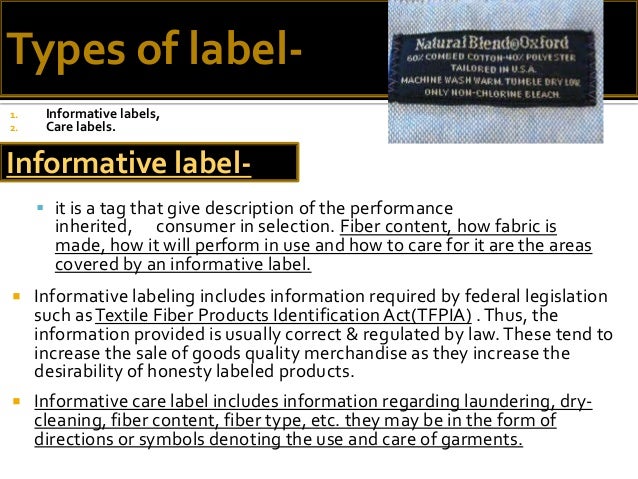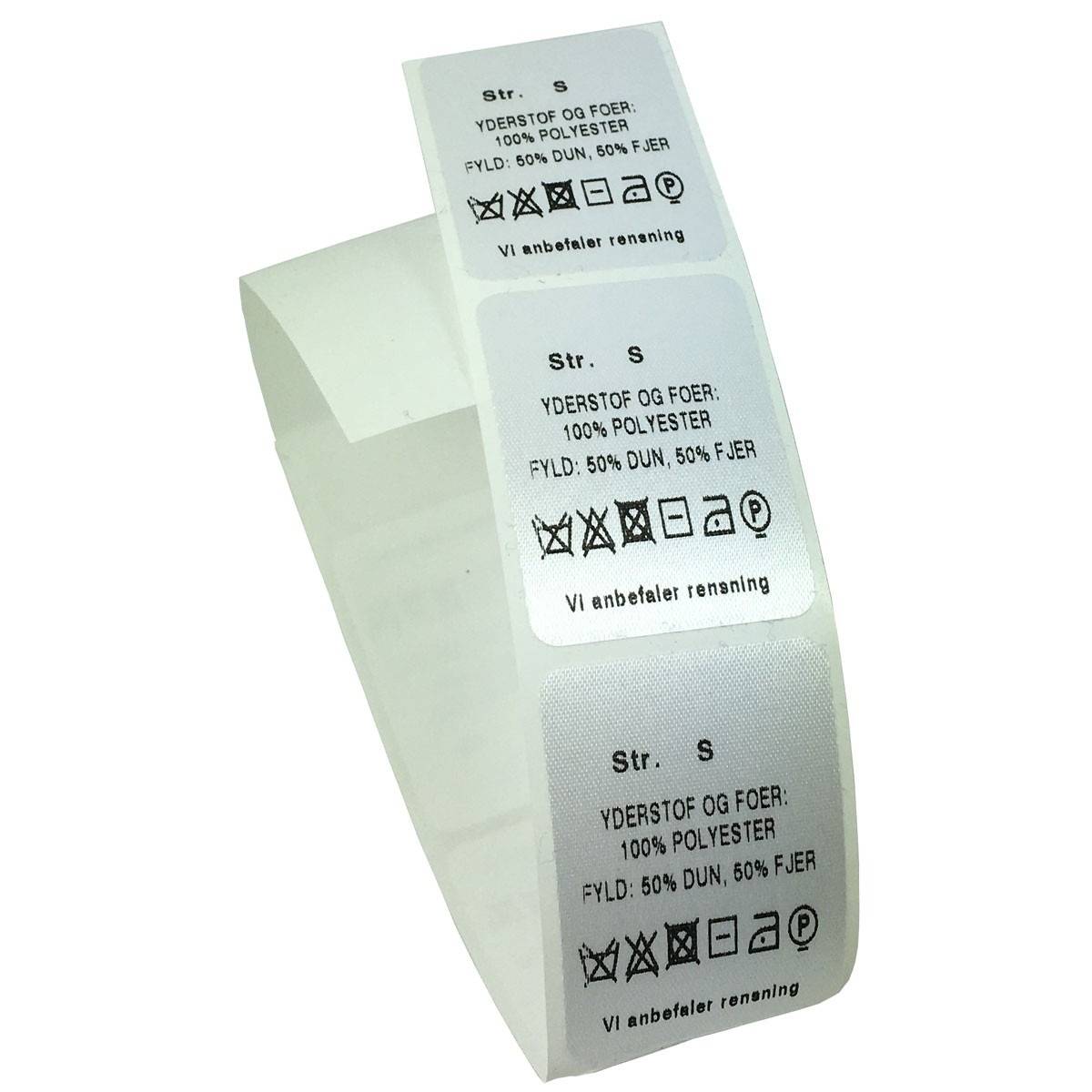40 importance of care labels in textiles
12 Sustainable Materials And Fabrics You Should Know About Shop Better By Knowing Your Fabrics. Conscious fashion can mean many different things, but one way to ensure a more mindful purchase is to shop for sustainably made garments.With fast fashion producing at a highly accelerated rate to meet demand, manufacturers end up relying on virgin synthetic materials that are cheap and quick to produce. However, these fabrics (polyester, nylon, or acrylic ... Product safety rules and standards | business.gov.au This information can include labels for cosmetics and tobacco products or care labelling for clothing and textile products. Product safety regulation in Australia for general consumer goods is a shared responsibility between the Australian Competition and Consumer Commission (ACCC) and the states and territories product safety regulators.
A Guide to Laundry Care Symbols - The Spruce Care labels are mandated by the government in the United States and many countries to identify the fiber content of the fabric and provide care instructions. The international community uses five basic symbols for washing, drying, bleaching, ironing, and dry cleaning. Once you learn the basic shapes, interpreting the rest is pretty simple.

Importance of care labels in textiles
Caring for Your Clothes: How to Read Laundry Labels It's also a good idea to turn each piece of linen inside out and button up all the buttons, zipping up zippers, tying up ties, etc. The important part of this is, besides laundry labels, to investigate how each fabric behaves and wash it the best way possible. Always keep in mind that it also depends on the fabric's quality. TShirt Care Instructions: How to Take Care Of T-Shirts 2. Wash t-shirts with cold water. Wash in cold water is necessary of tshirt care instructions. Experts suggest washing T-shirts with cold water and drying them on a permanent press to avoid wrinkles. In fact, there is really no need to wash your t-shirts in hot water, cold water will do the job in most cases. Your Complete Guide to Understanding Care Labels Clothing labels include all sorts of valuable information, including laundry instructions and fiber composition. Understanding the fibers will help you gauge the comfort of the garment and predict how long it should last. Laundry instruction symbols can be confusing at first glance. We have decoded them into human language for you.
Importance of care labels in textiles. Laundry Symbols Chart Meaning Guide Instructions The care label must remain permanently attached to the clothing item throughout its life expectancy. The Federal Trade Commission requires U.S. care labels to present the laundering symbols in a specific order: Washing instructions include temperature and machine cycle. Bleaching instructions only include no bleach or non-chlorine bleach. Organic Linen Clothing: 6 Sustainable Brands (+Essential Facts) The company is the brainchild of Jules, who is a revered textile designer based out of Australia. Through Omness, Jules is able to focus on quality designs that are brought to life with precision and care. Every Omness linen garment is made by hand, and the company only uses natural fibers and organic seaweed dyes. How to Wash Linen? Best Linen Care Guide That You Need - Son de Flor Fill a small container with lukewarm water and add about a teaspoon of mild detergent. Submerge the linen garment in lukewarm water and let it soak for about 10 minutes. Gently make a gentle back and forth swish motion on linen clothes. Never twist, or scrub as it can damage the fabric. SA.GOV.AU - Labelling Importance of care labelling Care labelling is required to provide consumers with enough information to: know how to care for clothing and textile products have prior knowledge of costs, such as dry cleaning, in the ongoing care of clothing and textile products understand how to clean clothing and textile products properly - eg cold hand wash only
Medical Gowns | FDA They are used to protect the wearer from the spread of disease-causing microorganisms if the wearer comes in contact with potentially infectious liquid or solid material. They may also be used to... Summary of Cosmetics Labeling Requirements | FDA Cosmetics which may be hazardous to consumers when misused must bear appropriate label warnings and adequate directions for safe use. The statements must be prominent and conspicuous. Some... 20 Certifications and Standards for Textile Industry Businesses Textile testing helps companies, consumer groups, and the government to make sure textile materials are safe to use, of good quality, and are reasonable. Some of the widely popular certifications and standards in the textile industry are listed below. This article is submitted by Adita Banerjee. 1. Textile Laws & Regulations - Video & Lesson Transcript | Study.com The textile industry is global. It provides jobs to millions of people around the world. Textile goods are very important products for many economies, and for the people who make things like...
Colorfast Fabric and How It Affects Your Laundry - The Spruce For a more thorough test for specific detergents and laundry products, use the following tips: 1. Mix one teaspoon of the laundry product (detergent, stain remover, chlorine bleach, or oxygen bleach) with 1/2 cup of warm water. Stir well to mix and be sure that any powdered formulas are completely dissolved. 2. Turn to an interior seam or hem. 40+ Fabric care labels & Laundry washing symbols with their meanings Bleaching Care symbols for laundry 1. This indicates that you can use any type of bleach on the fabric. 2. This denotes that the garment should not be drycleaned. 3. This symbol indicates that you should only use non-chlorine bleach on the garment. The ingredient list of bleach will clearly say whether it contains chlorine or not. Cosmetic and Beauty: important claims on product labels ... - • Statista Published by Statista Research Department , Feb 2, 2022 This chart illustrates the product labeling and claims that global consumers find to be most important when they were buying cosmetic... Sea, Soil, and Circularity: A New Guide for Sustainable Textiles She explains that improper care greatly reduces the lifespan of a textile—laundering, for example, is one of the "worst things you can do to an item." A lack of quality and care means we are going to produce and consume a lot more items, which, for all the reasons listed above, is very damaging to the environment.
Textiles Labeling Requirements: 5 Things Every Designer MUST Know Labels can be made in a way that they are compliant with the regulations of several countries at the same time. Many brands meet both US and European Union textiles labeling simultaneously. It would only be necessary to create a label file that includes all of the information required for each country.
Scaling textile-to-textile recycling of used garments - the holy grail ... Effective textile-to-textile recycling of used garments plays an important role in achieving that vision and is considered by many industry leaders as the 'holy grail'. It comes with a specific set of challenges to tackle, many of them systemic in nature. Currently, worldwide only ±25% of discarded textiles are collected separately [2].
How to disinfect clothes: Tips for coronavirus (COVID-19) prevention However, high temperatures can damage or shrink delicate clothing items, so remember to read the care labels. Dry clothing completely. Disinfect laundry baskets with 0.1% sodium hypochlorite or one...
History of Clothing: Why Do We Wear Clothes - Bellatory People wear clothes for many reasons, primarily for protection and decoration. While it may seem that protection from the elements is the main function of clothing, the concept of decorating the body is an ancient practice, going back to the days of the Neanderthal who disappeared 30,000 years ago. Garments have been worn for thousands of years ...
Product Labeling Regulations in the US, EU and Australia Apparel and textiles labelling Clothing and textiles must be labeled according to FTC labeling requirements. This includes the following: Fiber composition Care labels Sizes CPSIA CPSIA is a framework regulation for toys and children's products. All products that fall within the scope of CPSIA must carry a "tracking label".
Clothing and Textiles Regulations in the United ... - Compliance Gate The standard provides a comprehensive system of symbols to represent care instructions for textile products. It also aims to provide a set of concise and easy-to-understand care symbols to reduce users' dependency on the instruction language. ASTM F1816 Standard Safety Specification for Drawstrings on Children's Upper Outerwear
Textile Industry: Significance & Advantages - Study.com Human Advantages To survive, humans need food, shelter, and warmth. Textiles fall into all of these categories. Because of clothing and protective gear, farmers can use fertilizers, herbicides, or...
Clothing and Textiles Regulations in the European Union: A Complete Guide The General Product Safety Directive (GPSD) aims to ensure the general safety of consumer products before they can be placed in the EU market. The GPSD covers consumer products, including clothing and textile products. It includes safety, labeling, and documentation requirements. EN standards
A list of 70+ Fabric finishes & treatments that will ... - Sew Guide Moire. A finish or process applied to fabrics in which the fabric gets a shimmering water rippled look, using engraved rollers, heat, pressure, steam and chemicals. This involves getting a mixed gloss and matt effect by crushing certain parts of the fabric. It is done on ribbed fabrics.
Label Embellishments for Stunning & Secure Personal Care Products While linen and estate papers have long been popular among wine brands, they are gaining traction in the personal care industry. The textured look and feel add an element of sophistication to any product. According to Packaging Gateway, "labels with a 'fashion textile' appeal" are gaining popular across a wide variety of industries.
Sustainable Dyeing Methods in Textile Industry - Textile Learner 2.3 Thermosol. This method is continuous method of dyeing with disperse dye. Here dyeing is performed at high temperature like 180-220 C in close vessel. In this process time of dyeing should be maintained very carefully to get required shade and to retain required fabric strength.
Japan - Labeling/Marking Requirements Last published date: 2022-01-08. Japanese law requires labels for products in many categories. Generally, labeling for most imported products is not required at the customs clearance stage, but at the point of sale. Consequently, Japanese importers commonly affix a label to an imported product after it has cleared customs.
Your Complete Guide to Understanding Care Labels Clothing labels include all sorts of valuable information, including laundry instructions and fiber composition. Understanding the fibers will help you gauge the comfort of the garment and predict how long it should last. Laundry instruction symbols can be confusing at first glance. We have decoded them into human language for you.
TShirt Care Instructions: How to Take Care Of T-Shirts 2. Wash t-shirts with cold water. Wash in cold water is necessary of tshirt care instructions. Experts suggest washing T-shirts with cold water and drying them on a permanent press to avoid wrinkles. In fact, there is really no need to wash your t-shirts in hot water, cold water will do the job in most cases.













Post a Comment for "40 importance of care labels in textiles"